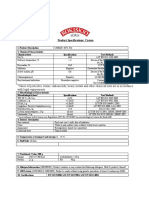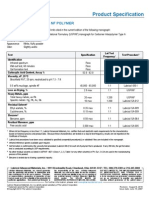HPMC
HPMC
Uploaded by
Anish Kumar ACopyright:
Available Formats
HPMC
HPMC
Uploaded by
Anish Kumar AOriginal Description:
Copyright
Available Formats
Share this document
Did you find this document useful?
Is this content inappropriate?
Copyright:
Available Formats
HPMC
HPMC
Uploaded by
Anish Kumar ACopyright:
Available Formats
HYDROXY PROPYL METHYL CELLULOSE Nonproprietary names: BP: Hypromellose JP: Hydroxypropylmethylcellulose PhEur: Hypromellosum USP: Hypromellose Synonyms:
yms: Benecel MHPC; Hydroxypropyl methylcellulose Chemical name and CAS registry number: Cellulose hydroxypropyl methyl ether [9004-65-3] Structural formula:
Functional category: Coating agent, film-former, rate-controlling polymer for sustained release, stabilizing agent, suspending agent, tablet binder, viscosity increasing agent. Description: HPMC is an odorless and tasteless, white or creamy-white fibrous or granular powder.
Typical properties: Acidity/alkalinity: pH = 5.58.0 for a 1% w/w aqueous solution. Density (bulk): 0.341 g/cm3 Density (tapped): 0.557 g/cm3 Density (true): 1.326 g/cm3 Melting point: Glass transition temperature is 170180C. Solubility: Soluble in cold water, forming a viscous colloidal solution; practically insoluble in chloroform, ethanol (95%) and ether, but soluble in mixtures of ethanol and dichloromethane, mixtures of methanol and dichloromethane, and mixtures of water and alcohol. Viscosity (dynamic): A wide range of viscosity types are commercially available. Aqueous solutions are most commonly prepared; Dichloromethane and ethanol mixtures may also be used to prepare viscous hypromellose solutions. Solutions prepared using organic solvents tend to be more viscous; increasing concentration also produces more viscous solutions. To prepare an aqueous solution, it is recommended that hypromellose is dispersed and thoroughly hydrated in about 2030% of the required amount of water. The water should be vigorously stirred and heated to 8090C and then the remaining hypromellose should be added. Then sufficient cold water should be added to produce the required volume. Incompatibilities: Hypromellose is incompatible with some oxidizing agents. Since it is nonionic, hypromellose will not complex with metallic salts or ionic organics to form insoluble precipitates. Applications in pharmaceutical formulation or technology: Hypromellose is widely used in oral, ophthalmic and topical pharmaceutical formulations. In oral products, hypromellose is primarily used as a tablet binder, in film coating, and as a matrix for use in extended-release tablet formulations. Concentrations between 2% and 5% w/w may be used as a binder in either wet or dry granulation processes. High-viscosity grades may be used to retard the release of drugs from a matrix at levels of 1080% w/w in tablets and capsules. Depending upon the viscosity grade; concentrations of 220% w/w are used for film-forming
solutions to film-coat tablets. Lower-viscosity grades are used in aqueous film-coating solutions while higher-viscosity grades are used with organic solvents. Examples of film-coating materials that are commercially available include Any Coat C, Spectracel, and Pharmacoat. Hypromellose is also used as a suspending and thickening agent in topical formulations. It is also used as an emulsifier, suspending agent, and stabilizing agent in topical gels and ointments.
You might also like
- Mebeverine Prolonged-Release Capsules - British PharmacopoeiaDocument3 pagesMebeverine Prolonged-Release Capsules - British PharmacopoeiaMuhammad Imran100% (1)
- Butaphosphane+Cyanocobalamin InjectionDocument5 pagesButaphosphane+Cyanocobalamin Injectionbejoy karimNo ratings yet
- Cyclohexanone MSDS: Section 1: Chemical Product and Company IdentificationDocument6 pagesCyclohexanone MSDS: Section 1: Chemical Product and Company IdentificationNada NovindaNo ratings yet
- PT. Kao Indonesia Chemicals: Neopelex F - 65Document1 pagePT. Kao Indonesia Chemicals: Neopelex F - 65Mona Mudrikah100% (1)
- MSDS-Neutriherbs Retinol CreamDocument4 pagesMSDS-Neutriherbs Retinol CreamYaseer Assot AllyNo ratings yet
- Edenor c12-99 MsdsDocument4 pagesEdenor c12-99 MsdstopguitarNo ratings yet
- Pharmaceutics: A Practical Manual for PHARM & PHARM D CoursesFrom EverandPharmaceutics: A Practical Manual for PHARM & PHARM D CoursesRating: 5 out of 5 stars5/5 (2)
- HypromelloseDocument5 pagesHypromellosehitham shehataNo ratings yet
- Minutesof286thmeetingofRegistration Board - 14jan2019 PDFDocument1,011 pagesMinutesof286thmeetingofRegistration Board - 14jan2019 PDFhamadashraf301No ratings yet
- Product Specifications: CreamDocument1 pageProduct Specifications: CreamJason Thornton0% (1)
- Evaluating The Effect of Varying Drying Air Temperatures On Quality Attributes of Avocado (Persea Americana) PeelsDocument7 pagesEvaluating The Effect of Varying Drying Air Temperatures On Quality Attributes of Avocado (Persea Americana) PeelsMamta AgarwalNo ratings yet
- Lactose GradesDocument8 pagesLactose GradesdrantistNo ratings yet
- Tds Transcutol CGDocument3 pagesTds Transcutol CGSanggari Mogaraja100% (2)
- Tds Lipocire A SGDocument3 pagesTds Lipocire A SGrafaeldelperuNo ratings yet
- Managemen Farmasi UTS2 + Generik 499 FixDocument14 pagesManagemen Farmasi UTS2 + Generik 499 FixreffadaNo ratings yet
- Spray Dried Lactose (p.376-378) 405-407 PDFDocument3 pagesSpray Dried Lactose (p.376-378) 405-407 PDFMarsha Fendria PrastikaNo ratings yet
- Pantoprazole SodiumDocument47 pagesPantoprazole SodiumronaldotimmNo ratings yet
- Brochure Ecipient BL PHI May 2019 FINALDocument16 pagesBrochure Ecipient BL PHI May 2019 FINALvinay100% (1)
- PPT-SpecWhite? DL-MA Mandelic Acid-Brightening-Especially Designed AHA For Sensitive Skin Type 20200605Document27 pagesPPT-SpecWhite? DL-MA Mandelic Acid-Brightening-Especially Designed AHA For Sensitive Skin Type 20200605Kenneth CfkNo ratings yet
- New Formulation and Evaluation of Domperidone SuspensionDocument18 pagesNew Formulation and Evaluation of Domperidone Suspensionethylenepluschlorine100% (1)
- Bardac 2250 MSDSDocument10 pagesBardac 2250 MSDSgregorypage2No ratings yet
- Eudragit CoatingDocument14 pagesEudragit CoatingshrinivastNo ratings yet
- SPEC Carbopol Ultrez 10 NFDocument1 pageSPEC Carbopol Ultrez 10 NFNataly Morón100% (1)
- Specification Eudragit L 30 D 55Document6 pagesSpecification Eudragit L 30 D 55Jivan Battu100% (1)
- Coa Caramel FPDocument1 pageCoa Caramel FPTantriyani GunadyNo ratings yet
- Ferrous Fumarate Antimony GluconateDocument6 pagesFerrous Fumarate Antimony Gluconatefurqan ahmadNo ratings yet
- Polyethylene Glycol 6000Document4 pagesPolyethylene Glycol 6000hemya7No ratings yet
- Stability of Carbopol Gels Containing Hydrogen PeroxideDocument5 pagesStability of Carbopol Gels Containing Hydrogen PeroxidePatrick BurnsNo ratings yet
- Profile of Pharmaceutical Sector in BangladeshDocument23 pagesProfile of Pharmaceutical Sector in Bangladeshtanim_buetNo ratings yet
- Opadry II Reconstitution 0Document2 pagesOpadry II Reconstitution 0Luis MoraNo ratings yet
- Turunan Imidazoline Crodazoline oDocument2 pagesTurunan Imidazoline Crodazoline oMuhammad Syarif HidayatullahNo ratings yet
- Indian Pharmacopoeia (2010) Vol-IDocument731 pagesIndian Pharmacopoeia (2010) Vol-Iqc jawaNo ratings yet
- Powders and GranuleswhatDocument47 pagesPowders and GranuleswhatJezreel JavierNo ratings yet
- SPC 138523Document4 pagesSPC 138523Pankaj ArgalNo ratings yet
- Acyclovir Cream IVPT FDA 2020Document13 pagesAcyclovir Cream IVPT FDA 2020Widia TriNo ratings yet
- Acyclovir CreamDocument6 pagesAcyclovir CreamMuqeet KazmiNo ratings yet
- Ampho FDA Webinar PSG 1694370912Document25 pagesAmpho FDA Webinar PSG 1694370912Amruta JethwaNo ratings yet
- Opadry IiDocument2 pagesOpadry IiJudey PretoriusNo ratings yet
- Ophthalmic ProductsDocument17 pagesOphthalmic ProductsAmrit GaireNo ratings yet
- Ceracara MLS AC45 - PT (En) - NFC210129 CeramideDocument18 pagesCeracara MLS AC45 - PT (En) - NFC210129 CeramideMihaela Simona IsacNo ratings yet
- Preformulasi Prak Tikum 2Document9 pagesPreformulasi Prak Tikum 2Ani KurniaNo ratings yet
- Priced Products (01-01-2023)Document1,677 pagesPriced Products (01-01-2023)AmerNo ratings yet
- Korean Pharmacopoeia Up To DateDocument36 pagesKorean Pharmacopoeia Up To DateLuisNo ratings yet
- GRANULES Presentation PDFDocument18 pagesGRANULES Presentation PDFsouvik.cjNo ratings yet
- Food and Agricultural Import Regulations and Standards - Narrative - Beijing - China - Peoples Republic of - 12!12!2013Document63 pagesFood and Agricultural Import Regulations and Standards - Narrative - Beijing - China - Peoples Republic of - 12!12!2013Nguyen Thanh TrungNo ratings yet
- TDS Euperlan PK 1200 UPDocument4 pagesTDS Euperlan PK 1200 UPMarvin Dias Santos0% (1)
- Opadry IIDocument2 pagesOpadry IIMaríaAntezanaNo ratings yet
- Safety Data Sheet Product IdentificationDocument6 pagesSafety Data Sheet Product Identificationverpacking pimNo ratings yet
- AD0012LC Post Column Derivatization AflatoxinDocument4 pagesAD0012LC Post Column Derivatization Aflatoxinevenspase7859No ratings yet
- Analisis Simetikon PDFDocument9 pagesAnalisis Simetikon PDFArini Musfiroh50% (2)
- Multivitamin StabilityDocument5 pagesMultivitamin Stabilityanand1540100% (1)
- Favipravir PresentationDocument35 pagesFavipravir PresentationSanjay Sharma100% (5)
- Gujarat Themis Presentation Nov 2021Document30 pagesGujarat Themis Presentation Nov 2021Puneet367No ratings yet
- Lidocaine - British PharmacopoeiaDocument4 pagesLidocaine - British PharmacopoeiaAinul HudaNo ratings yet
- Sterotex NFDocument3 pagesSterotex NFBIONATURNo ratings yet
- Patent EP2808010A1 - Syrup Formulation of Salbutamol - Google PatentsDocument5 pagesPatent EP2808010A1 - Syrup Formulation of Salbutamol - Google PatentsMuhammadAmdadulHoque100% (1)
- Chapter-3 Polymer ProfileDocument5 pagesChapter-3 Polymer ProfileRajivNo ratings yet
- Hydroxypropyl CelluloseDocument4 pagesHydroxypropyl CelluloseHani AlhelwaniNo ratings yet
- Applications of PPG and PEGDocument3 pagesApplications of PPG and PEGDr.A.GayathriNo ratings yet
- Bahan Uts Semsol 2Document16 pagesBahan Uts Semsol 2melvaNo ratings yet
- MacrolidesDocument9 pagesMacrolidesAnish Kumar ANo ratings yet
- Definitions of Aseptic ProcessingDocument1 pageDefinitions of Aseptic ProcessingAnish Kumar ANo ratings yet
- AshokaDocument40 pagesAshokaAnish Kumar ANo ratings yet
- Hospital Pharmacy - LECTURE 8Document34 pagesHospital Pharmacy - LECTURE 8Anish Kumar A100% (1)
- Citric AcidDocument2 pagesCitric AcidAnish Kumar ANo ratings yet
- PVP K30Document1 pagePVP K30Anish Kumar ANo ratings yet
- HPMCDocument3 pagesHPMCAnish Kumar ANo ratings yet
- Pharma CaluculationsDocument5 pagesPharma CaluculationsAnish Kumar ANo ratings yet
- Formulation Development and Evaluation of Pantoprazole Delayed Release TabletsDocument13 pagesFormulation Development and Evaluation of Pantoprazole Delayed Release TabletsAnish Kumar A0% (1)




































































